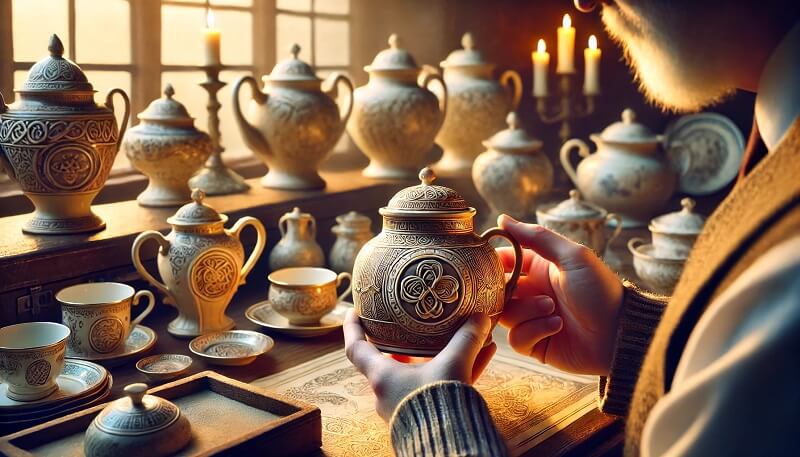How Can You Tell How Old Belleek Pottery Is?
Collecting Belleek Pottery is a fascinating journey into the craftsmanship and history of fine Irish porcelain. With its origins dating back to 1857, Belleek's intricate designs and heritage make each piece unique, and many collectors find themselves wondering how to tell the age of their pottery. In this comprehensive guide, we will explore the different ways to determine the age of Belleek Pottery, while also highlighting how we can help you save money on your next Belleek purchase using our latest voucher codes. Not only do we help you save, but your savings also contribute to a charitable cause, with 20% of our profits being donated to charity each month.

Understanding the History of Belleek Pottery
Belleek Pottery, established in the quaint village of Belleek in Northern Ireland, is one of the oldest and most esteemed pottery producers in the world. Founded by John Caldwell Bloomfield in 1857, Belleek Pottery became famous for its delicate craftsmanship and high-quality porcelain. Over the years, the pottery's unique features, such as the distinctive lustrous glaze, have attracted collectors from around the globe.
Understanding the history of Belleek is crucial for identifying the age of its pottery. The brand has evolved through different periods, with each era leaving its mark on the design and craftsmanship of Belleek pieces. Knowing these changes can help you accurately date your Belleek pottery.
Identifying Belleek Pottery Marks
Types of Marks Used Over the Years
One of the most reliable ways to determine the age of a Belleek Pottery piece is by examining its backstamp, or pottery mark. Belleek has used different marks over the years, which makes it possible to narrow down the production period of each piece. Here is a breakdown of the different Belleek marks:
-
First Period Mark (Black Mark) (1863–1890): The earliest Belleek mark features a black harp, a wolfhound, and a round tower, with the word "Belleek" and "Co Fermanagh, Ireland." This mark is known as the First Period Black Mark.
-
Second Period Mark (Black and Green Marks) (1891–1926): From 1891 onwards, Belleek introduced both black and green marks. This period also saw the introduction of the phrase "Made in Ireland" to indicate origin, following the McKinley Tariff Act.
-
Subsequent Marks (1930s onward): Over the decades, Belleek has continued to update its marks to reflect different periods, including changes in font, colour, and added details like trademarks and copyright symbols.
These backstamps provide a visual clue to the pottery's age, and collectors often rely on these marks to determine the value of their pieces. More information on Belleek's different marks and their timelines can be found here.
Determining the Age of Belleek Pottery Using the Marks
To determine the age of your Belleek Pottery piece, start by carefully examining the mark on the bottom. Comparing this mark to known examples can give you a fairly accurate estimate of its production period. However, keep in mind that some pieces may have marks that are harder to read or identify due to wear or production anomalies. Websites like Belleek Collectors Society are useful resources for verifying backstamps and learning more about different Belleek marks.
Evaluating Design Features to Determine Age
The Evolution of Belleek’s Designs
In addition to backstamps, Belleek Pottery's designs have evolved over time, offering another way to determine a piece's age. The motifs and patterns used by Belleek have changed significantly since the pottery's early days. For example:
-
Early Designs: Belleek's early pieces often featured Celtic motifs, shamrocks, and naturalistic designs. These designs were elaborate and reflected the Victorian fascination with intricate detail.
-
Twentieth-Century Changes: Over time, Belleek adapted to changing tastes, introducing new styles and simplified patterns. Pieces from the mid-20th century onwards were often less elaborate but retained the distinctive Belleek quality.
Recognising the patterns and motifs specific to different eras is an effective way to estimate the age of a piece. Detailed information about Belleek's design evolution is available on their official website here.
Materials and Techniques
The materials and techniques used to create Belleek pottery also changed over time. Early Belleek pieces were known for their parian porcelain — a type of biscuit porcelain that closely resembled marble. The composition and quality of materials have evolved, with slight differences noticeable in later pieces.
Examining the texture, weight, and translucency of a Belleek piece can also offer hints about its age. Older pieces are often lighter and more translucent, while newer ones might have a different weight or glaze. Collectors can also look for tell-tale signs of early hand-finishing techniques versus modern production methods.
Using Reference Guides and Resources
Identifying Belleek Pottery can be complex, and collectors often turn to reference guides for help. There are several well-regarded books, such as "Belleek: The Complete Collector's Guide and Illustrated Reference" by Richard Degenhardt, which provide in-depth information about Belleek marks and designs. The Belleek Collectors Society also provides valuable resources and access to a community of Belleek enthusiasts who can help verify the age and authenticity of pieces.
Common Questions About Belleek Pottery Age Identification
How Do I Verify the Authenticity of My Belleek Piece?
Verifying the authenticity of Belleek Pottery involves examining the backstamp, materials, and craftsmanship. Authentic Belleek has a distinctively smooth and lustrous finish. If in doubt, seek advice from experienced collectors or refer to online resources such as the Belleek Collectors Society. Authentic pieces can also be more affordably acquired using our latest voucher codes for Belleek purchases, ensuring that you get genuine products without breaking the bank.
What Are the Most Sought-After Periods for Belleek Pottery?
The most valuable Belleek pieces are typically from the First and Second Periods. These early pieces are rarer and more intricately crafted, making them highly prized by collectors. When buying these pieces, make sure to check the mark and use trusted voucher codes to get the best possible price while ensuring authenticity.
Saving Money on Belleek Pottery with Voucher Codes
At My Favourite Voucher Codes, we are committed to helping collectors and enthusiasts acquire Belleek Pottery at the best possible prices. By using our Belleek voucher codes, you can save money on your purchase of fine porcelain pottery. Not only do you save on your shopping, but your participation also contributes to a greater cause — 20% of our profits are donated to charity every month, allowing you to give back to the community while enhancing your collection.
Be sure to check our site regularly for the latest Belleek voucher codes and take advantage of exclusive discounts that make owning a piece of Irish heritage more affordable.
Conclusion
Determining the age of Belleek Pottery is an art in itself, involving careful examination of backstamps, design features, materials, and craftsmanship. Whether you are a seasoned collector or just beginning your journey, knowing how to tell the age of your Belleek pieces adds significant value and meaning to your collection.
With our voucher codes, not only can you save money on your next Belleek Pottery purchase, but you can also make a difference by contributing to charitable causes. Visit our website to find the latest deals and start building your collection today.
by Julian House 23rd October 2024





